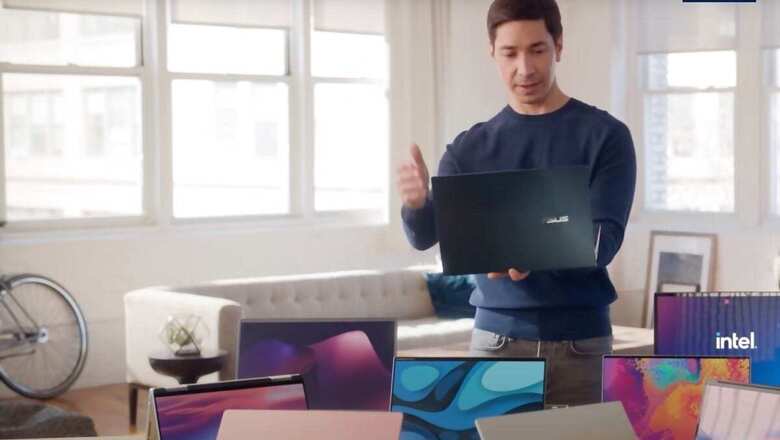
views
What would you have expected Intel to do as a response to the blazing fast Apple M1 chip released late last year with the new Apple MacBook Air and MacBook Pro? Make better processors that at least match the benchmark that the M1 set? But what does Intel do? In an attempt to counter the distinct disadvantage that most of their Intel Core processors have compared with the Apple M1, the company has instead rolled out a set of video advertisements. The biggest achievement of these ads may just be that they’ve managed to get the former star of Apple’s “I’m a Mac” ads, Justin Long on board. The idea is to pit Intel powered laptops and convertibles running Windows 10 against Apple Macs. It is all fine and dandy to make cool looking ads and package what would otherwise have been a boring spec sheet comparison on a spreadsheet, but where’s the substance beyond the style?
I’ll quickly summarize what the ads say. Basically, what Intel has is a checklist for you, a checklist of what its ecosystem devices have and therefore believes those features are important. The lack of touchscreens on Macs, that Macs aren’t really seen as gaming devices, M1’s lack of multi-monitor support, mocking Apple’s MacBook Touch Bar and calling the colour choices “grey and greyer”. The reality, and let us illustrate that with a real world example here, is quite interesting as you see it unfolding. You spend around Rs 92,900 for an Apple MacBook Air with the M1 chip—and you get what is the fastest performing machine in the ultraportable space, by far. Let us take what is perhaps the best that Intel has to offer in that space in conjunction with Microsoft for the Windows 10 operating system and various PC makers. You’ll be spending around Rs 1,01,990 for a significantly lower performance of the Microsoft Surface Laptop 3 (a 10th generation Intel Core i5 processor and 13.5-inch touch display). The Microsoft Surface Pen, mind you, costs around Rs 9,500 additionally. The new Dell XPS 13 (9310) has prices starting upwards of Rs 1,49,990 for an 11th generation Intel Core i5 processor. The HP Spectre x360 convertible 13 is priced upwards of Rs 1,14,999.
This is very much an illustration of Intel trying to battle the perception, at least on YouTube, while there is no sign of any response in terms of substance and new chips that match the current Apple M1. Mind you, Apple won’t be standing still with the next chip expected to be featuring the Apple MacBook and iMac refreshes this year. And that’ll further push the performance benchmark. While it is all great to have a touchscreen and a stylus with a Windows 10 laptop or convertible computing device, they are and will remain simple add-ons that you’ll use from time to time. at least that is how it will be for most users. Admittedly, the Touch Bar on MacBook’s isn’t exactly redefining utility either. Plus, think about it, if Windows 10 really worked well in a touchscreen environment, wouldn’t we have had more Windows 10 tablets running Intel chips?
The ads are plainly surprising, considering Intel’s new CEO Pat Gelsinger had said all the right things earlier this year. “We have to deliver better products to the PC ecosystem than any possible thing that a lifestyle company in Cupertino. We have to be that good, in the future,” Gelsinger is believed to have told employees, as reported by The Oregonian newspaper at the time.
The Intel and Apple separation started in the summer of 2020, when Apple announced that they’ll be switching all Mac computing devices to their own Apple Silicon chips, replacing the Intel Core processors. According to numbers, the first generation M1 chips are 3.5x faster than the Intel chips they replace in the Apple MacBook Air. And 2.8x faster than the Intel chips in the Apple MacBook Pro. Those performance improvements in the world of computing devices, pretty much means the second best is pretty much being left standing still. In fact, the MacBook Air is faster than 98 percent of PC laptops sold in the last year, according to Apple. It can deliver significantly higher performance for the CPU and graphics at much lower power consumption, compared with chips that power Windows laptops. If that is the sort of power and efficiency that can be drawn out of the ultra-slim and fan-less MacBook Air, one doesn’t really need to guess too hard to understand the sort of power the M1 chip holds.
Cool ads on YouTube and video platforms are all nice to see and create conversation. But for a company like Intel, the response shouldn’t be coming on YouTube. And the scoop being they poached the “I’m a Mac” guy. The response should be with the hardware, the chips taking a significant leap forward in terms of performance. But then again, that is exactly what Intel’s problem has been, which has also seen rivals AMD swoop in and take a sizeable share of the PC market. As per numbers by research firm Statista, at the end of Q4 2020, AMD with a constantly increasing market share through the year had cornered 38.6% with Intel’s share now at 61.4%. AMD had j22.85 share in Q4 2018. This is indicative of Intel’s lack of a big push with generation after generation of Intel Core chips. For instance, Intel persisted with the 14nm nodes from 2014 all the way to the end of 2018, which included the Broadwell, Skylake, Kaby Lake and Coffee Lake generations. Performance and power consumption gains have been just too little, something Apple didn’t want. And Intel may do well to look over their shoulder from time to time, because AMD is slowly looming large in the mirrors.
Read all the Latest News, Breaking News and Coronavirus News here


















Comments
0 comment